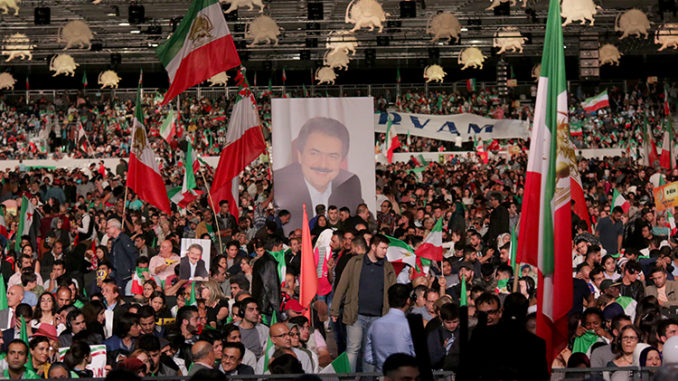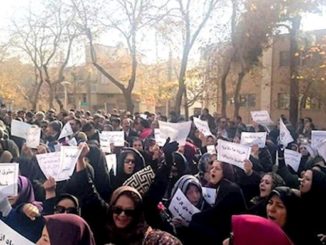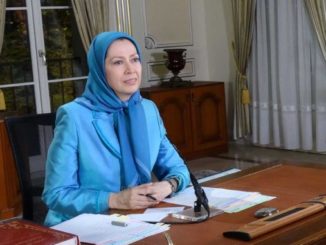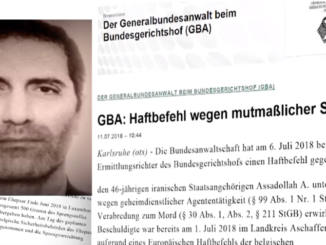
During the last year’s grand gathering of Iranians in Paris, Mrs. Maryam Rajavi, President-elect of the NCRI, stated:
“The light of change is shining on Iran.”
“The ruling regime is more than ever in disarray and paralyzed.”
“The Iranian society is simmering with discontent. And the international community is finally getting closer to the reality that appeasing this regime is misguided.”
In recent days, many top officials of the Mullahs’ regime have come to the scene to acknowledge some aspects of the escalating crises awaiting the regime and the threat of the overthrow of the whole system. Among these top officials were the Supreme Leader Ali Khamenei, President Hassan Rouhani, and Sadeq Larijani, the head of the judiciary, who pointed to the regime’s critical situation.
In assessing the possible factors for the confusion and panic of the regime’s heads and alignment of its factions who are impressed by the severity and intensity of the regime’s grappling crises and are chorusing in unison over the “widespread crises”, the fact outstands that all these political mobilizations and propaganda campaigns are neither improvised nor accidental. Indeed the real problem is mirrored in most state-run media as raising a question over the survival of the entire regime in one of the most threatening era of its life.
But what is the main problem?
Rouhani, the regime’s president, for example, during a meeting with economic activists emphasized the need for the so-called interacting with the world and stated that the general policy of the regime is just a single sentence so that if the decision is made, the country would be totally transformed.
Rouhani implicitly says that the issues of interacting with the world and continuation of the nuclear deal according to the United States’ conditions have been jammed behind a decision that can be made only by Khamenei and no one else.
In his comments, Rouhani reminded China’s experience, which once symbolized the policy of self-isolation in the contemporary world versus the policy of open-doors to the world. Rouhani said that while China with such a large population was not able to solve its problems and was forced to return to the policy of open doors, the clerical regime also needs to follow the same path and change its policy as soon as possible.
But Khamenei, speaking in a session with the Basiji students, essentially denied the existence of the crisis and said: “The (regime’s) situation is very good!” However, as the statements of the highest ranks of the regime clarify, these contradictory remarks suggest the escalating internal crisis due to the global isolation of the regime.
Larijani in his speech summarized the crises engulfing the regime in four categories:
1) The crisis caused by international isolation
2) The social crisis
3) The internal crisis
4) The crisis caused by the increasing influence of the democratic alternative to the regime, the National Council Resistance of Iran (NCRI) and its core group, the People Mojahedin Organization of Iran (PMOI/MEK).
Larijani also noted some of the crises’ depth and said:
“Officials, by solving livelihood problems as much as possible, should not allow a simple problem turns into a security issue.” Threatening those who “intend to exploit certain issues to endanger the security of the country and the people,” Larijani stated that the regime “would not be just onlooker but would strongly confront them.”
What Larijani said was, in fact, restating Khamenei’s speech on January 9, 2018, and his first address after the Iranian people’s uprising on late December 2017 and early January 2018. The peril of the organized resistance apparently has become the main source of concern for the survival of the regime. Warning about the MEK’s danger has become the main measure for the regime in confronting the crises that have surrounded it.
In conclusion, as Mrs. Maryam Rajavi, the President-elect of the NCRI, remarked about the explosive conditions of the Iranian society during the last year’s grand gathering of Iranians in Paris in which hundreds of international figures and over 100,000 Iranian expatriates participated:
“The light of change is shining on Iran.
The ruling regime is more than ever in disarray and paralyzed. The Iranian society is simmering with discontent.
And the international community is finally getting closer to the reality that appeasing this regime is misguided.”
Mrs. Maryam Rajavi added: “These intense circumstances speak of three fundamental truths for achieving freedom in Iran and peace and tranquility in the region:
First, the overthrow of the religious dictatorship ruling Iran is an imperative.
Second, the overthrow of this regime is within reach.
And third, the existence of a democratic alternative and an organized resistance capable of toppling the religious tyranny in Iran.”
The end of religious tyranny followed by a democratic change in Iran is inevitable.




